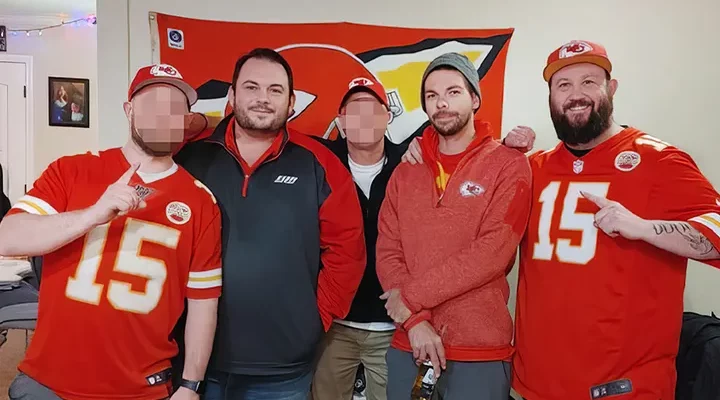The chilling discovery of three deceased Kansas City Chiefs fans in a friend’s backyard in January 2024 sent ripples of shock and sorrow through the community and beyond. What began as a baffling mystery has now escalated into a pivotal legal battle, with two suspects, Jordan Willis and Ivory Carson, facing murder charges for the first time. This unprecedented development marks a crucial turning point in a case that has captivated public attention, raising complex questions about accountability, drug-related deaths, and the interpretation of existing laws.
The narrative of the Kansas City Chiefs fans’ deaths is a somber one, unfolding over several days in the cold grip of a Kansas City winter. Ricky Johnson, 38, David Harrington, 37, and Clayton McGeeney, 36, all avid Chiefs supporters and longtime friends, had gathered at Jordan Willis’s rental home to watch a football game. What transpired after the game, and why these men were later found deceased in the backyard, became the central enigma of the initial investigation. It was McGeeney’s fiancée, April Mahoney, who, after days of unanswered calls and growing concern, forced her way into Willis’s home on January 9, 2024, only to make the horrific discovery of the three frozen bodies outside.
The initial stages of the investigation were marked by a lack of concrete answers, fueling widespread speculation and a frenzy of online theories. The Kansas City Police Department, facing immense public pressure, diligently worked the case for 14 months, waiting for forensic reports and all facts to come to light. The silence from authorities, while necessary for a thorough investigation, was frustrating for the grieving families and a curious public. This period of uncertainty underscored the complexities inherent in such cases, particularly when the circumstances are unusual and direct witnesses are scarce.
A breakthrough arrived with the forensic examination results, which determined that Johnson, Harrington, and McGeeney all died of “fentanyl and cocaine combined toxicity.” This finding shifted the focus of the investigation dramatically. The presence of these potent substances pointed toward drug use as a critical factor in their deaths, transforming the inquiry from one of unexplained demise to a potential drug overdose scenario.
With the toxicology reports in hand, prosecutors began to build a case centered on the premise that the suspects supplied the drugs that led to the fatal overdoses. This is where the legal framework of Missouri’s felony murder rule comes into play, a rule that is now at the heart of this high-stakes legal test. The felony murder rule, a controversial yet firmly established legal principle in many jurisdictions, allows for a murder charge to be brought against an individual who causes a death during the commission of a separate felony, even if there was no intent to kill. In this instance, prosecutors allege that the felony committed was drug distribution, and the deaths of the three men occurred as a direct result of that illegal activity.
Jordan Willis and Ivory “Blade” Carson were initially charged with three counts of involuntary manslaughter and two counts of delivery of a controlled substance. These charges, while serious, carry a maximum sentence of 10 years. However, the decision by prosecutors to upgrade these charges to second-degree felony murder signifies a more aggressive legal strategy, one that carries far graver potential consequences for the defendants. Both Willis and Carson have pleaded not guilty to the charges, setting the stage for a contentious legal battle.
The evidence presented by prosecutors to support the murder charges is multifaceted. Court documents allege that Willis provided the drugs that ultimately killed the victims, and that Carson supplied additional controlled substances in the weeks leading up to the tragedy. Specifically, court records indicate that Willis was a “major contributor of DNA” found on a bag of a “white powdery substance” discovered in his home, while Carson’s DNA was allegedly found on a bag containing fentanyl, and he admitted to selling cocaine to Willis and the victims prior to January 2024. Witnesses reportedly present at the football watch party also told police that they “drank, smoked marijuana and used cocaine,” with one witness claiming to have seen a “large plate of cocaine allegedly supplied by Mr. Willis that everyone was using” at Harrington’s home before they even arrived at Willis’s residence. This suggests a pattern of drug use and supply that prosecutors aim to link directly to the victims’ deaths.
The defense, particularly for Jordan Willis, has strongly contested these charges. Willis’s attorney, John Picerno, has repeatedly stated that his client maintains his innocence and is not responsible for the deaths of his friends. Picerno argues that Willis went to sleep while the other men were still awake, and that he was unaware they were still in his backyard, let alone in distress, until police arrived. He also highlights that there is no direct evidence that Willis purchased the specific drugs that led to the fatal overdoses, suggesting that the men had been partying all day and could have obtained substances from various sources. Picerno has called the application of Missouri’s felony murder statute in this case “unusual” and “overly broad,” stating that in his 30 years of practice, he has never seen it used in this manner. He intends to challenge the charges vigorously in court and has indicated he will file a motion to sever Willis’s case from Carson’s, arguing that the men should not be tried together. This strategy aims to prevent any potentially damaging evidence against Carson from prejudicing the jury against Willis.
The legal arguments surrounding the felony murder rule are central to this case. Understanding this rule is critical to grasping the implications of these murder charges. The felony murder rule is a controversial doctrine because it allows for a murder conviction without proof of intent to kill. The rationale behind it is to deter individuals from committing dangerous felonies, as they will be held accountable for any deaths that occur during the commission of that felony, even if accidental or unforeseen. However, critics argue that it can lead to disproportionately harsh sentences, particularly for individuals who may have had only a tangential involvement in the death or who did not foresee the fatal outcome. In this case, the prosecution’s success will hinge on their ability to convincingly demonstrate that the act of drug distribution by Willis and Carson directly caused the deaths of Johnson, Harrington, and McGeeney. The defense will undoubtedly challenge this causation, arguing that other factors, such as the victims’ own choices or the potential for drugs to have been obtained elsewhere, break the chain of causality necessary for a murder conviction.
The “crucial test” for this case lies in how the legal system interprets and applies the felony murder rule in the context of drug overdose deaths. This is a rapidly evolving area of law, as the opioid crisis and the increasing prevalence of fentanyl have led to a re-evaluation of how drug suppliers are held accountable for fatalities. Historically, such cases might have resulted in charges of involuntary manslaughter or drug distribution, but the trend in some jurisdictions is towards more severe charges, including murder, particularly when fentanyl is involved due to its extreme potency and lethality. This case could set a significant precedent in Missouri and potentially influence similar prosecutions nationwide.
Beyond the legal technicalities, the human element of this tragedy remains paramount. The families of Ricky Johnson, David Harrington, and Clayton McGeeney have endured immense pain and a prolonged period of uncertainty. For them, these upgraded charges represent a step closer to justice and accountability for the loss of their loved ones. They have consistently voiced their frustration with the initial pace of the investigation and their desire for answers. The pursuit of murder charges reflects, in part, the societal demand for accountability in the face of preventable drug-related deaths.
However, the case also highlights the complexities of personal responsibility and the devastating impact of drug use. The victims, by all accounts, were friends who engaged in recreational drug use. While their deaths are tragic, the legal system must grapple with the extent to which those who supply drugs, even casually among friends, can be held criminally liable for unforeseen fatal outcomes. This is not to diminish the severity of drug distribution, but rather to acknowledge the nuanced ethical and legal considerations involved in applying murder charges in such circumstances.
The public’s perception of the case has been heavily influenced by social media, where speculation and amateur sleuthing ran rampant in the absence of official information. This amplified the families’ calls for answers and put additional pressure on law enforcement. The transparent and thorough presentation of evidence by the prosecution and the robust defense mounted by the accused will be vital in ensuring that the legal proceedings are perceived as fair and just, regardless of the eventual outcome.
The upcoming trial will be a significant event, drawing national attention. The prosecution will need to present a compelling case that establishes, beyond a reasonable doubt, that Willis and Carson’s actions in distributing drugs directly led to the deaths. This will likely involve detailed testimony from forensic experts regarding the cause of death, evidence linking the defendants to the specific drugs consumed by the victims, and potentially testimony from other witnesses who were present that night. The defense, in turn, will seek to sow doubt, emphasizing the absence of intent to kill, the victims’ own choices, and any weaknesses in the chain of evidence linking the defendants to the fatal fentanyl and cocaine.
The outcome of this case will undoubtedly have a profound impact on all involved. For the families of the victims, it offers the hope of closure and a measure of justice. For Willis and Carson, their freedom and future hang in the balance. For the legal community, it will be a closely watched examination of the felony murder rule’s application in the context of drug overdose deaths, potentially shaping future prosecutions and legal precedents. This is more than just a local tragedy; it’s a critical legal and societal test, forcing a deeper examination of culpability in an era grappling with the pervasive dangers of illicit drug use. The unfolding drama in the Kansas City courts will serve as a stark reminder of these complex issues and the enduring quest for justice.



